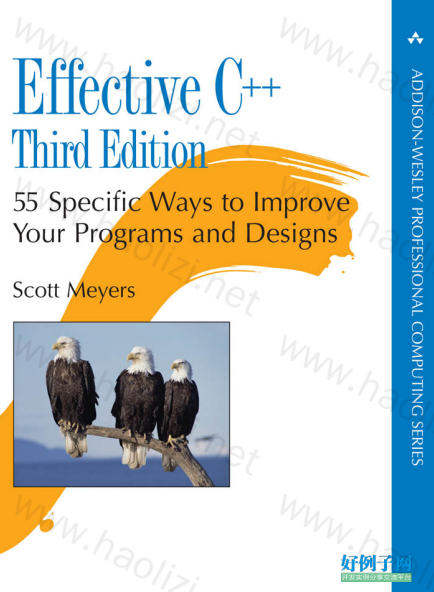实例介绍
【实例简介】
【实例截图】

【核心代码】
Preface xv Acknowledgments xvii Introduction 1 Chapter 1: Accustoming Yourself to C 11 Item 1: View C as a federation of languages. 11 Item 2: Prefer consts, enums, and inlines to #defines. 13 Item 3: Use const whenever possible. 17 Item 4: Make sure that objects are initialized before they’re used. 26 Chapter 2: Constructors, Destructors, and Assignment Operators 34 Item 5: Know what functions C silently writes and calls. 34 Item 6: Explicitly disallow the use of compiler-generated functions you do not want. 37 Item 7: Declare destructors virtual in polymorphic base classes. 40 Item 8: Prevent exceptions from leaving destructors. 44 Item 9: Never call virtual functions during construction or destruction. 48 Item 10: Have assignment operators return a reference to *this. 52 Item 11: Handle assignment to self in operator=. 53 Item 12: Copy all parts of an object. 57 Chapter 3: Resource Management 61 Item 13: Use objects to manage resources. 61 Contents ptg7544714 xii Contents Effective C Item 14: Think carefully about copying behavior in resource-managing classes. 66 Item 15: Provide access to raw resources in resource-managing classes. 69 Item 16: Use the same form in corresponding uses of new and delete. 73 Item 17: Store newed objects in smart pointers in standalone statements. 75 Chapter 4: Designs and Declarations 78 Item 18: Make interfaces easy to use correctly and hard to use incorrectly. 78 Item 19: Treat class design as type design. 84 Item 20: Prefer pass-by-reference-to-const to pass-by-value. 86 Item 21: Don’t try to return a reference when you must return an object. 90 Item 22: Declare data members private. 94 Item 23: Prefer non-member non-friend functions to member functions. 98 Item 24: Declare non-member functions when type conversions should apply to all parameters. 102 Item 25: Consider support for a non-throwing swap. 106 Chapter 5: Implementations 113 Item 26: Postpone variable definitions as long as possible. 113 Item 27: Minimize casting. 116 Item 28: Avoid returning “handles” to object internals. 123 Item 29: Strive for exception-safe code. 127 Item 30: Understand the ins and outs of inlining. 134 Item 31: Minimize compilation dependencies between files. 140 Chapter 6: Inheritance and Object-Oriented Design 149 Item 32: Make sure public inheritance models “is-a.” 150 Item 33: Avoid hiding inherited names. 156 Item 34: Differentiate between inheritance of interface and inheritance of implementation. 161 Item 35: Consider alternatives to virtual functions. 169 Item 36: Never redefine an inherited non-virtual function. 178 ptg7544714 Effective C Contents xiii Item 37: Never redefine a function’s inherited default parameter value. 180 Item 38: Model “has-a” or “is-implemented-in-terms-of” through composition. 184 Item 39: Use private inheritance judiciously. 187 Item 40: Use multiple inheritance judiciously. 192 Chapter 7: Templates and Generic Programming 199 Item 41: Understand implicit interfaces and compile-time polymorphism. 199 Item 42: Understand the two meanings of typename. 203 Item 43: Know how to access names in templatized base classes. 207 Item 44: Factor parameter-independent code out of templates. 212 Item 45: Use member function templates to accept “all compatible types.” 218 Item 46: Define non-member functions inside templates when type conversions are desired. 222 Item 47: Use traits classes for information about types. 226 Item 48: Be aware of template metaprogramming. 233 Chapter 8: Customizing new and delete 239 Item 49: Understand the behavior of the new-handler. 240 Item 50: Understand when it makes sense to replace new and delete. 247 Item 51: Adhere to convention when writing new and delete. 252 Item 52: Write placement delete if you write placement new. 256 Chapter 9: Miscellany 262 Item 53: Pay attention to compiler warnings. 262 Item 54: Familiarize yourself with the standard library, including TR1. 263 Item 55: Familiarize yourself with Boost. 269 Appendix A: Beyond Effective C 273 Appendix B: Item Mappings Between Second and Third Editions 277 Index 280 ptg7544714 This page intentionally left blank
好例子网口号:伸出你的我的手 — 分享!
小贴士
感谢您为本站写下的评论,您的评论对其它用户来说具有重要的参考价值,所以请认真填写。
- 类似“顶”、“沙发”之类没有营养的文字,对勤劳贡献的楼主来说是令人沮丧的反馈信息。
- 相信您也不想看到一排文字/表情墙,所以请不要反馈意义不大的重复字符,也请尽量不要纯表情的回复。
- 提问之前请再仔细看一遍楼主的说明,或许是您遗漏了。
- 请勿到处挖坑绊人、招贴广告。既占空间让人厌烦,又没人会搭理,于人于己都无利。
关于好例子网
本站旨在为广大IT学习爱好者提供一个非营利性互相学习交流分享平台。本站所有资源都可以被免费获取学习研究。本站资源来自网友分享,对搜索内容的合法性不具有预见性、识别性、控制性,仅供学习研究,请务必在下载后24小时内给予删除,不得用于其他任何用途,否则后果自负。基于互联网的特殊性,平台无法对用户传输的作品、信息、内容的权属或合法性、安全性、合规性、真实性、科学性、完整权、有效性等进行实质审查;无论平台是否已进行审查,用户均应自行承担因其传输的作品、信息、内容而可能或已经产生的侵权或权属纠纷等法律责任。本站所有资源不代表本站的观点或立场,基于网友分享,根据中国法律《信息网络传播权保护条例》第二十二与二十三条之规定,若资源存在侵权或相关问题请联系本站客服人员,点此联系我们。关于更多版权及免责申明参见 版权及免责申明



网友评论
我要评论